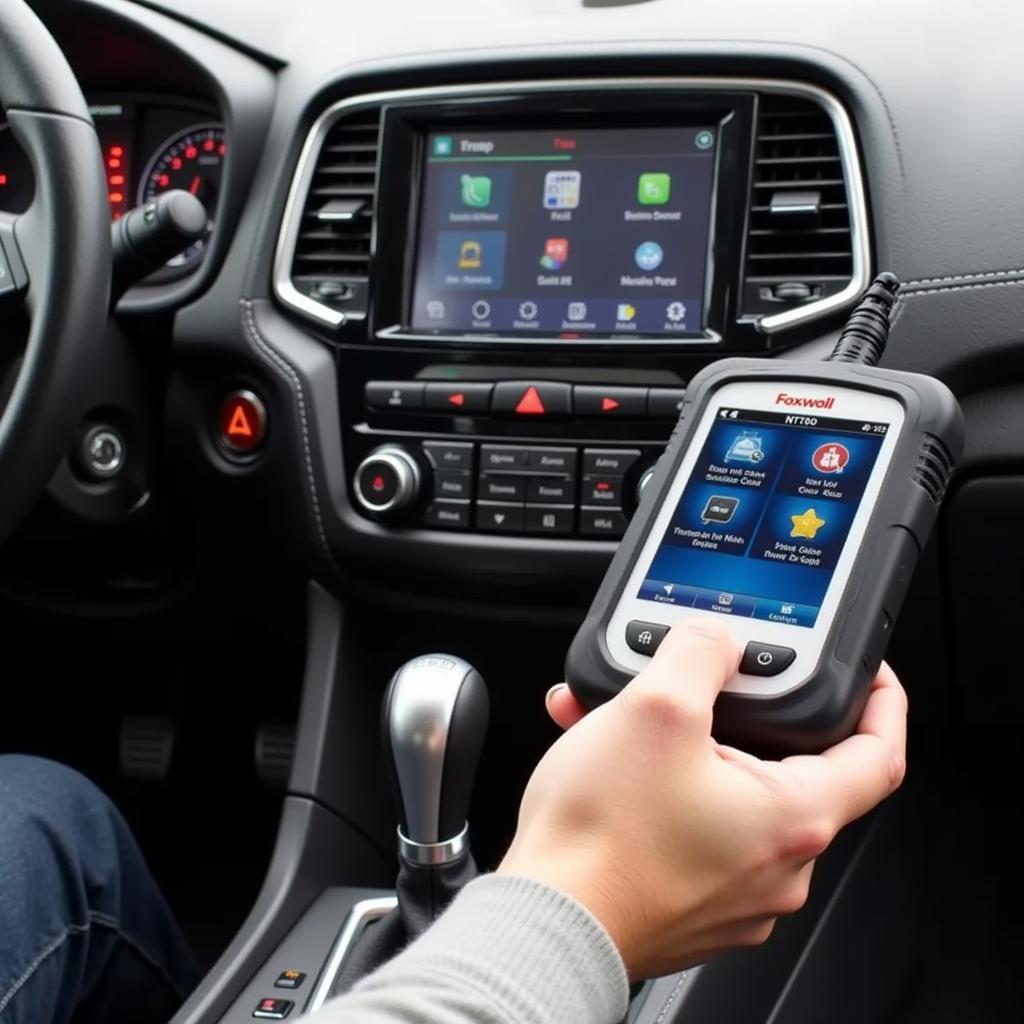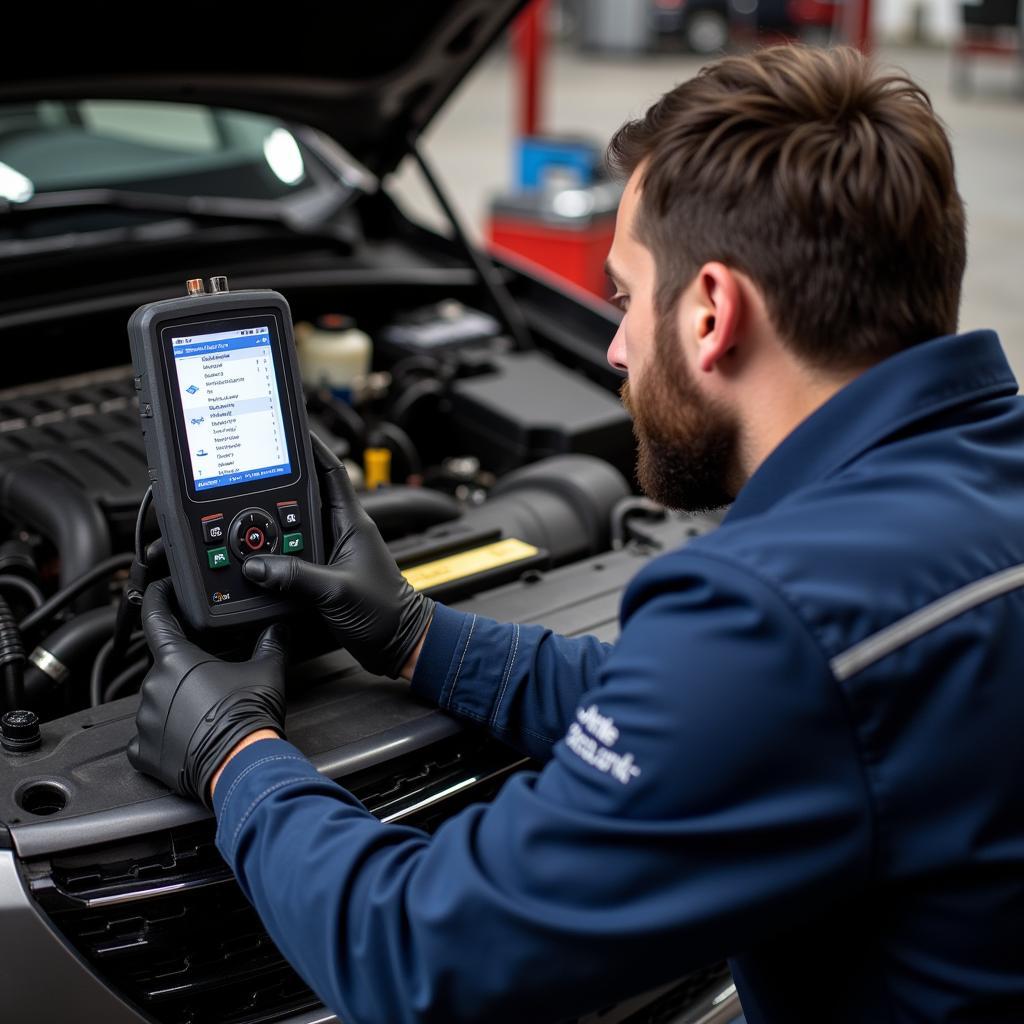Using a Foxwell scan tool to diagnose and resolve TPMS issues is a smart move for both car owners and professional mechanics. This guide provides a detailed walkthrough of how to utilize the power of Foxwell to conquer TPMS problems effectively.
Understanding TPMS and Its Significance
TPMS, or Tire Pressure Monitoring System, is a crucial safety feature in modern vehicles. It constantly monitors tire pressure and alerts the driver if any tire deviates significantly from the recommended pressure. Properly inflated tires are essential for:
- Enhanced Safety: Underinflated tires can overheat and lead to blowouts, while overinflation compromises tire grip and increases the risk of accidents. TPMS helps prevent these dangerous situations.
- Improved Fuel Efficiency: Underinflated tires create more rolling resistance, forcing your engine to work harder and consume more fuel. Maintaining optimal tire pressure with the help of TPMS ensures optimal fuel economy.
- Extended Tire Lifespan: Driving with incorrect tire pressure causes uneven tread wear, shortening the lifespan of your tires. TPMS helps you avoid this by promoting proper inflation, ultimately saving you money in the long run.
Why Choose Foxwell for TPMS Management?
Foxwell diagnostic tools are renowned for their user-friendliness, comprehensive functionality, and affordability, making them a popular choice among car enthusiasts and professional mechanics. Here’s why Foxwell stands out for TPMS tasks:
- Wide Vehicle Coverage: Foxwell scanners support a wide range of car makes and models, ensuring compatibility with your vehicle.
- Specialized TPMS Functions: From reading and clearing TPMS codes to programming new sensors, Foxwell tools offer a suite of specialized functions to address various TPMS needs.
- Intuitive Interface: Foxwell scanners feature intuitive menus and easy-to-understand instructions, making them accessible even for users with limited technical expertise.
- Cost-Effective Solution: Compared to expensive dealership visits, Foxwell tools provide a budget-friendly solution for diagnosing and resolving TPMS issues yourself.
Step-by-Step Guide to Using TPMS on Foxwell
Let’s dive into a step-by-step guide on using the TPMS functionalities of your Foxwell scanner:
- Connect and Power Up: Connect the Foxwell scanner to your vehicle’s OBD-II port, typically located under the dashboard on the driver’s side. Turn on the ignition, but do not start the engine.
- Access TPMS Function: Navigate through the Foxwell scanner’s main menu using the directional buttons or touchscreen, depending on your model. Look for an option labeled “TPMS,” “Tire Pressure,” or something similar.
- Select Your Vehicle: The scanner may prompt you to input your vehicle’s information, including the make, model, and year. This ensures the tool communicates correctly with your vehicle’s TPMS system.
- Choose the Desired Action: Foxwell scanners offer a range of TPMS functions, such as:
- Read TPMS Codes: This option retrieves any stored TPMS fault codes, providing insights into potential issues like sensor malfunctions or system errors.
- Clear TPMS Codes: After addressing the root cause of a TPMS issue, use this function to erase stored codes and reset the warning light on your dashboard.
- Display Sensor Data: This allows you to view live data from each tire pressure sensor, including pressure readings, temperature, battery status, and sensor ID.
- Program New Sensors: If you’ve replaced one or more TPMS sensors, this function helps you program the new sensors to your vehicle’s TPMS system.
- Follow On-Screen Instructions: Each function comes with clear, step-by-step instructions on the scanner’s screen. Carefully follow these instructions to complete the desired action.
- Verify and Clear: After performing any TPMS function, always verify that the issue is resolved. Check the dashboard for warning lights and refer to the scanner’s display for confirmation.
Common TPMS Issues and Troubleshooting Tips
Understanding common TPMS issues can help you diagnose and address them effectively:
1. Low Tire Pressure Warning Light:
- Cause: The most common cause is simply underinflated tires. However, it can also indicate a slow leak, a faulty sensor, or a problem with the TPMS system itself.
- Solution: Check tire pressure using a reliable gauge. Inflate tires to the recommended pressure listed on the driver’s side door jamb. If the light persists, use your Foxwell scanner to check for TPMS codes and inspect sensors for damage.
2. TPMS Sensor Battery Replacement:
- Cause: TPMS sensors have internal batteries with a lifespan of around 5-10 years. When the battery dies, the sensor can’t transmit data.
- Solution: Use your Foxwell scanner to check sensor battery status. If a battery is low, replace the sensor. Remember to program the new sensor to your vehicle.
3. TPMS System Malfunction:
- Cause: Issues with the TPMS control module, wiring harnesses, or communication between components can cause system malfunctions.
- Solution: A Foxwell scanner can read and clear relevant fault codes, aiding in pinpointing the root cause of the malfunction. For complex electrical issues, seeking professional help is recommended.
Expert Insights
“TPMS issues, while common, are often easily addressed with the right tools and knowledge,” says John Miller, Senior Automotive Technician at ScanToolUS. “A Foxwell scanner empowers car owners and technicians to take control of TPMS diagnostics and repairs, saving time and money in the long run.”
Conclusion
Mastering TPMS with a Foxwell scan tool puts you in the driver’s seat when it comes to maintaining optimal tire pressure and ensuring your safety on the road. From reading and clearing codes to programming new sensors, the capabilities of Foxwell empower you to tackle TPMS tasks with confidence. Remember to always consult your vehicle’s owner’s manual and follow safety precautions when working on your car.
For expert assistance and top-quality Foxwell scan tools, contact ScanToolUS at +1 (641) 206-8880 or visit our office at 1615 S Laramie Ave, Cicero, IL 60804, USA.


